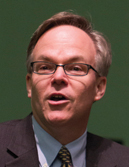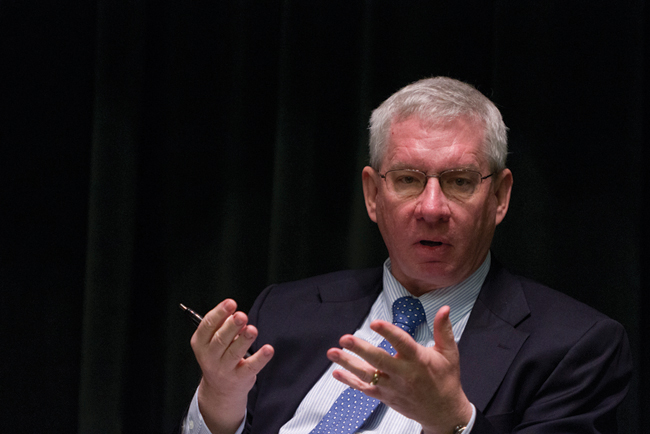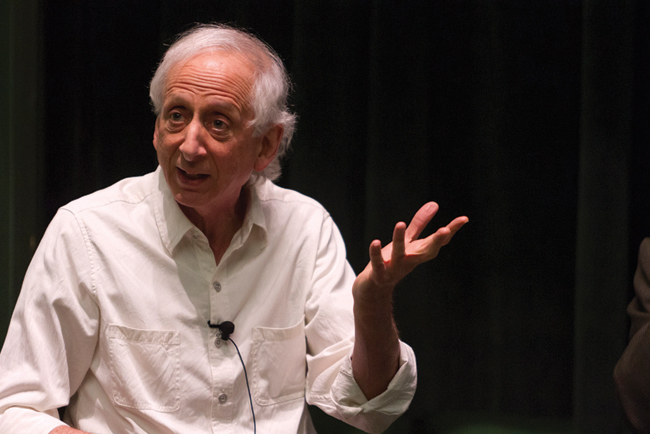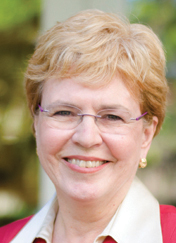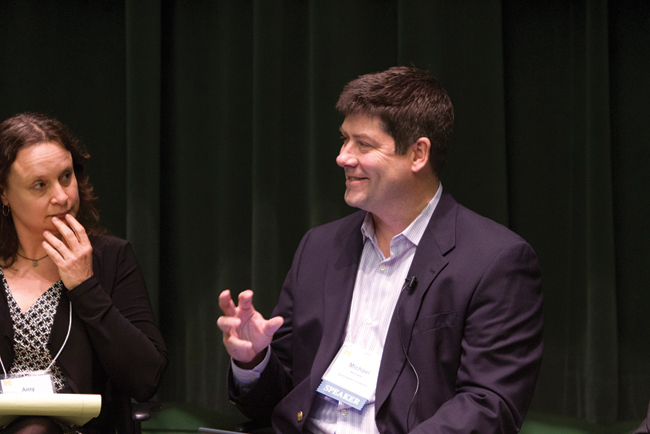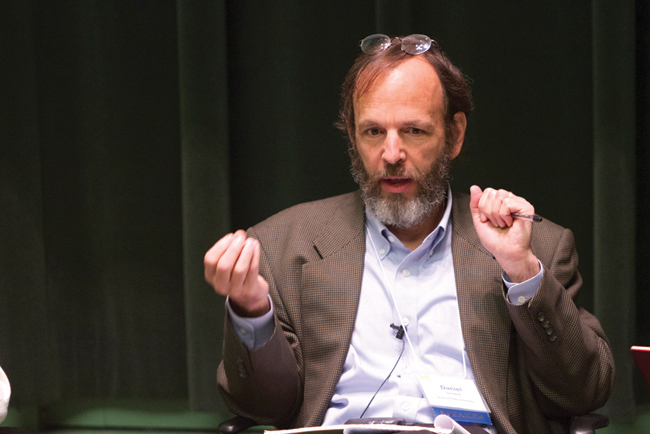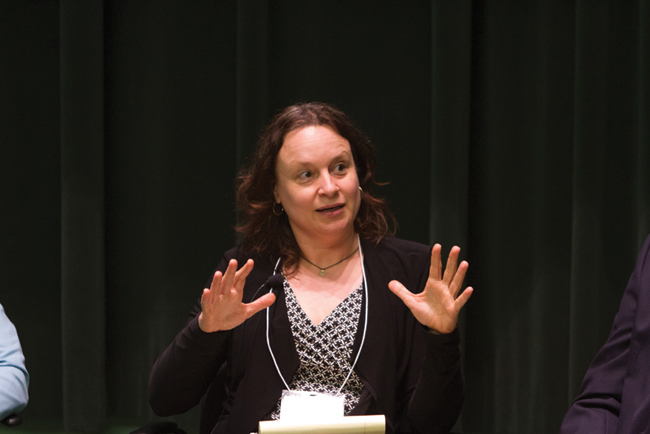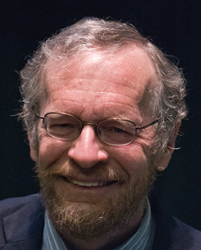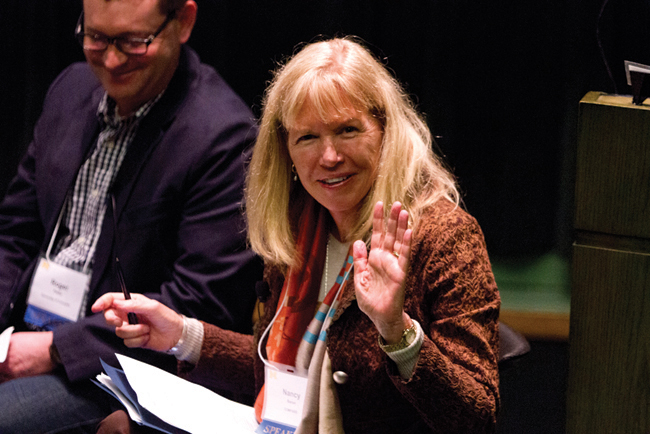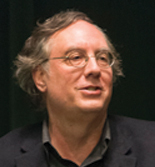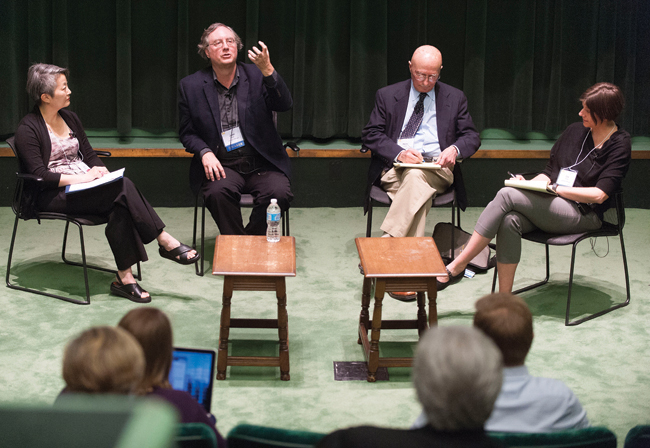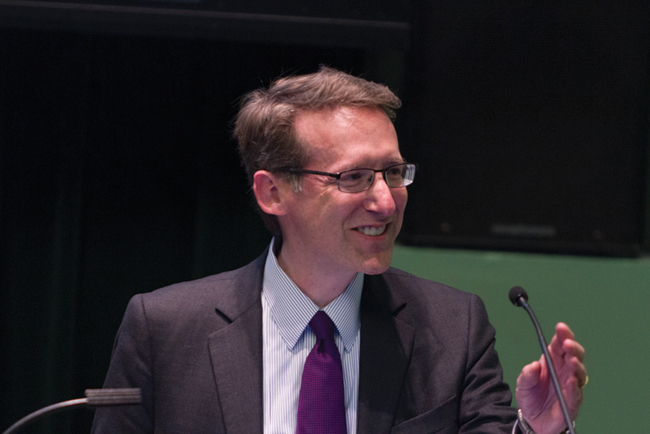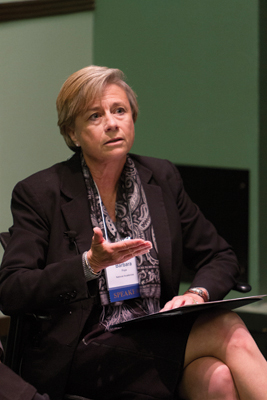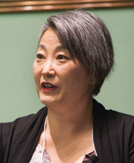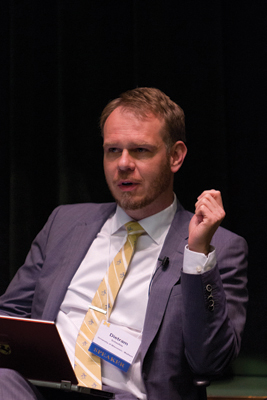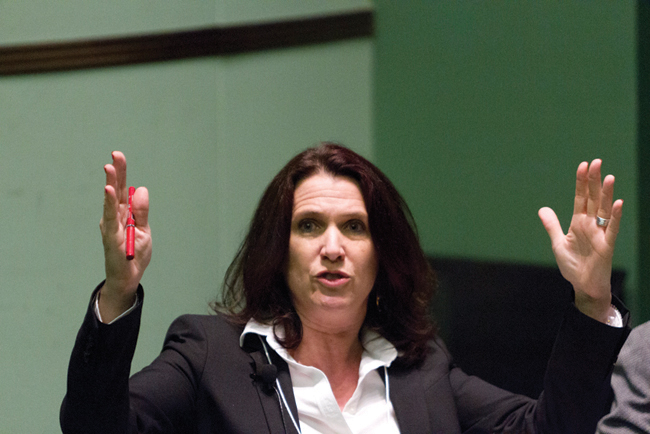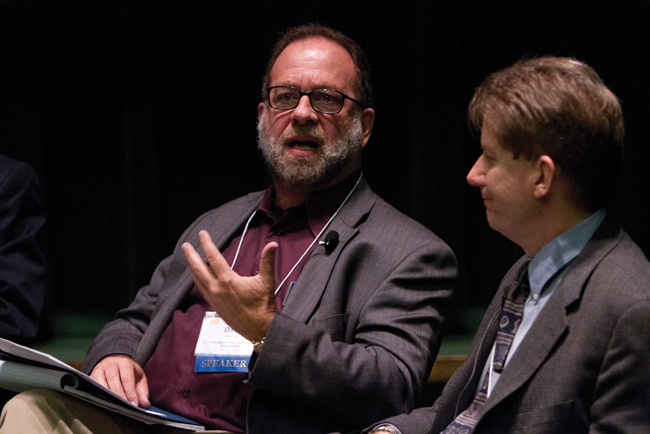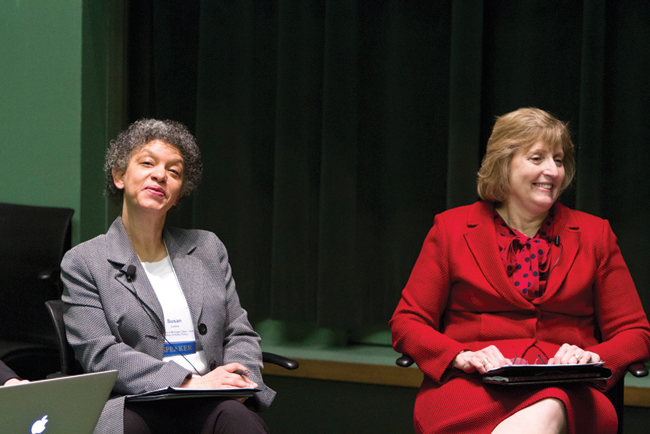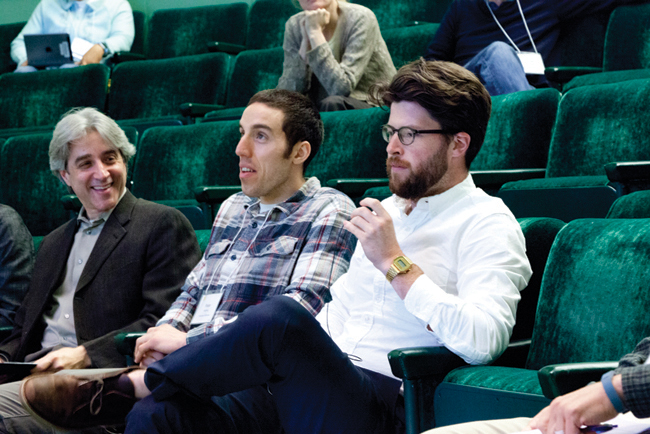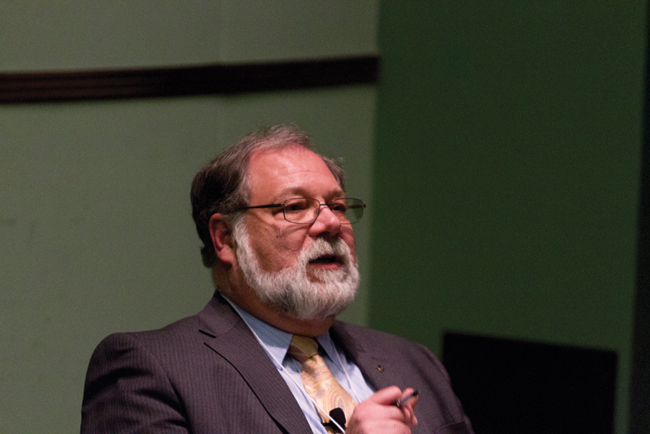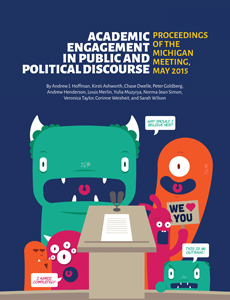
Academic Engagement in Public and Political Discourse: Proceedings of the Michigan Meeting, May 2015
Skip other details (including permanent urls, DOI, citation information): This work is protected by copyright and may be linked to without seeking permission. Permission must be received for subsequent distribution in print or electronically. Please contact [email protected] for more information.
For more information, read Michigan Publishing's access and usage policy.
3 Summary Report
The Presidents’ Point of View
The opening panel included four university presidents in a discussion that tracked the topics of the overall meeting and set the tone for continued discussion. The three themes were why we should engage, how to engage, and how to overcome obstacles to engagement. Although the presidents stressed that the paths to engagement may evolve distinctly among universities, many conclusions were relevant to all.
Why we should engage. President Hanlon (Dartmouth College) summarized three reasons for engagement: (1) we have an obligation to do it, (2) tenure is a privilege that is designed to encourage engagement, and (3) it is necessary for enhancing public debate. President Schlissel (University of Michigan) agreed that “it’s actually a responsibility or even an obligation of universities to engage in public discourse and to share the expertise that we accumulate, the knowledge we discover, and the understanding that we achieve with the public at large.” Beyond this, he added that tenure should facilitate public engagement: “We forget the privilege it is to have lifelong security of employment at a spectacular university. And I don’t think we use it for its intended purpose. I think that faculty on average through the generations are becoming a bit careerist and staying inside their comfort zones.” Panelists also felt that the academy should engage to enhance the public debate. In the words of Regent Kathy White (University of Michigan), “Research can only benefit society if we take responsibility for translating this research and inserting it into public discourse.” But, warned President Sullivan (University of Virginia), this belief is not universally shared: “There is a fundamental critique among some that we shouldn’t be doing research at all—that it’s not our mission and that our mission is only teaching. And if you haven’t heard that, you haven’t been walking the halls of the State Houses lately.” Finally, President Schlissel pointed out that engagement is necessary to ensure the relevance and longevity of the university: “If we’re perceived as being an ivory tower and talking to one another and being proud of our discoveries and our awards and our accomplishments and the letters after our names, I think in the long run the enterprise is going to suffer in society’s eyes and our potential for impact will diminish. The willingness of society to support us will decrease.” President Crow (Arizona State University) agreed, but with more urgency: “If we don’t figure out how to deal with this—how to teach what theory actually is, how to get people to understand that, how to translate, and how to deal with our tone—the gap between the academic elite and everyone else will continue to grow, and what we now see as political debate will be people with pitchforks outside the door . . . They want to know what we’re doing, why we exist, and why they’re giving us money. This is a very serious thing that we need to focus on.”
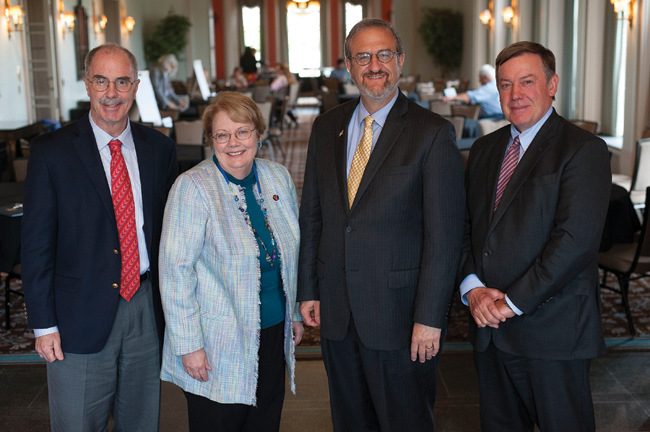
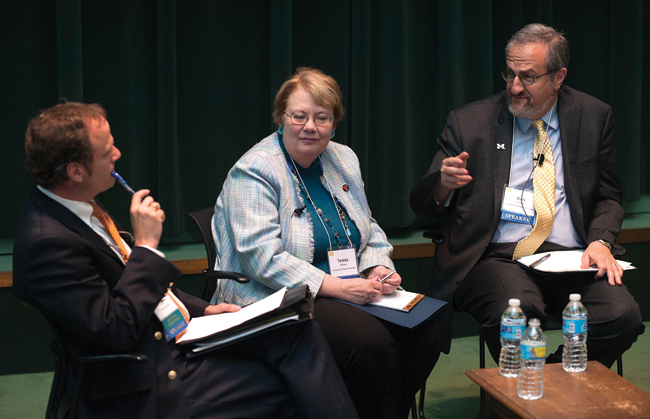
How to engage. In the end, the decision to engage is up to the individual scholar. As President Schlissel explained, “All our schools, all our individual faculty, are free agents. So there’s no mechanism to say that we’re all going to go this way. Are you kidding me? We can’t even get everybody to show up to a meeting.” But, he added, “I think it is a leadership thing and leadership at many different levels. Someone in the president’s position or a dean or a chair’s position can motivate behavior by celebrating individuals and their successes.” Enhancing public debate has become especially pertinent due to the “ubiquity of knowledge” available through social media platforms and new technology. Conversations take place in virtual space; on comment sections of blogs, news sites, and social media; and in online forum sessions. This poses enormous challenges to civil discourse and public dialogue. All four presidents expressed concern with this development. President Hanlon warned that “the real challenge is to focus on the readers . . . If we don’t do anything else with our students, we should teach them how complex the world’s issues are. We should teach them the difference between anecdote and data.” In looking at public debates, President Crow saw confusion more than willful ignorance. To overcome it, he said we need to “articulate the hierarchy of knowledge and explain the way in which knowledge evolves. What’s information? What’s knowledge? What’s know-how? What’s not? . . . We need to make sure that people understand that there is a hierarchy to all this and get them to understand it and respect it.” President Sullivan added that “there is indeed a big gap between sound bite and nuance . . . I don’t think we’ve got the issue of the gap figured out yet, and maybe there’s some new interstitial medium we don’t know about yet, or that hasn’t been invented yet, that will help us do that.” But, she continued, despite this, the insights that social media can provide can help the academy engage. According to President Schlissel, “We need to come to realize that we carry access to the world’s information in our pockets, so we don’t need to teach students too many facts. We need to teach them how to think and analyze and how to look for facts.” He added that social media is “not a gauge of what’s true or false or misleading or correct,” but it is an “accurate gauge of what people are thinking.”
Overcoming obstacles to engagement. According to President Crow, the root of the problem is in the universities themselves. He urged the academy to improve the “Three Ts”—how we teach, how we translate, and the tone of our discussions. “We are increasingly filled with hubris, filled with arrogance, cut off from the general public, and unable to find an appropriate tone with which to communicate . . . We need to communicate in ways that we’ve never even thought about before.” In addition to working on these skills, increasing diversity was viewed as obligatory. According to President Schlissel, “Unless we can create a milieu here that somewhat replicates the diversity of thought in society, it’s going to be very hard for us to work through the problem. So I don’t fear our faculty representing themselves and being considered liberal. I’m more concerned that we haven’t created a sufficient intellectually and politically diverse community on our campus.” Similarly, changing the culture of the university and the roles of various players within it came to the forefront of the discussion. Moderator Andrew Hoffman (University of Michigan) asked if “we have too many senior professors thinking like junior professors,” to which President Crow responded with a call to redefine a role for the full professor: “We’re starting to create positions of knowledge curators and educational technology specialists who will be working with our faculty to project their identities and build translation capabilities around them . . . with that, a full professor in this particular world becomes like a super faculty member . . . Scholars don’t have the kind of identity in the United States that they have in China and other places, and there are reasons for that that need to be addressed.” To help that process along, President Sullivan noted that “you have the right and perhaps the obligation to speak out. And I think our position as administrators is that we have the right and the obligation to protect that when faculty do.”
The full transcription of the presidents’ panel is in Chapter 5.
Why Should Academics Engage in Public and Political Discourse?
Despite an initial reaction that the question of whether we should engage was in some ways rhetorical, this proved to be a topic that was revisited repeatedly during the conference. In both the panel discussions and breakout sessions, the theme of motivation cut to the heart of the issue: that the academy is facing an existential crisis, and its approach to public and political discourse is fundamental not just to the success of the academy’s efforts to connect and engage with society but to its future survival. Many academics approached engagement as a duty, a responsibility born from financial or moral obligations to a public that, via one route or another, funds academic positions and research. Jane Lubchenco (Oregon State University) called engagement part of “scientists’ social contract.” In the words of Matthew Davis (University of Michigan), “Knowing something is a deflated currency—academia must bridge the ‘know’ to ‘do’ gap to be successful and relevant.”
Charles Eisendrath (University of Michigan) reminded us that public communication is experiencing a second revolution through social media and changes in the world of publishing, one that is bringing about changes as profound as the first, the invention of the Gutenberg press. Society now has instant access to more news, more stories, more information, more varied formats, and more sources than ever before. For universities to remain relevant, they must learn to engage in a relevant and meaningful way and at a relevant pace. He also added that there are two departments within the university system that are adapting quite effectively to the need for engagement: athletics and development. The scholarly portion of the institution is still lagging.
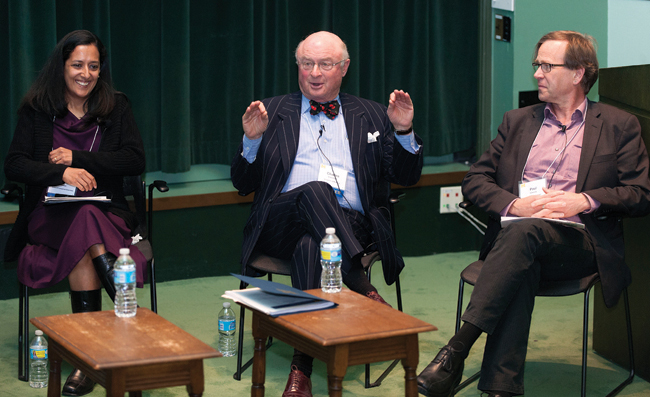
But Don Kettl (University of Maryland) stressed that this lag is unnecessary, that there is tremendous value in what the academy provides: “In Washington, DC, they are not just hungry for knowledge, for hard facts to inform their decision making; they are famished for it. They are looking to us to provide it.” But if academics choose not to enter into dialogue with politicians and their advisors, the vacuum will be filled by others with different methods, motives, and positions of authority. In the words of Rachel Cleetus (Union of Concerned Scientists), “If we elect to sit on the sidelines, we allow those with the loudest voices to channel the debate.” Many felt that there is a vital role for the academic scholar in public and political discourse, and we must fill it.
Another, perhaps even more powerful, reason for engaging is to excite and inspire, to enthuse a new generation to take up the torch and continue the commitment to inquiry and the pursuit of knowledge in academia. And that will only happen if we can demonstrate the connection between what we do as an institution and its benefit to society.
A little closer to home, some felt that academic engagement can also make the difference in terms of recruitment and retention. If academia does not embrace the opportunity represented by public engagement, it runs the risk of losing the best and brightest young scholars who “want to make a difference” through their work, further reducing diversity in its ranks. This was crystallized by a comment from the floor that academic engagement has a key role to play in embracing underserved populations and addressing the “leaky pipeline” issue. Baruch Fischhoff (Carnegie Mellon University) added that “the intellectual health of our disciplines depends on undertaking this kind of engagement.”
Eric Pooley (Environmental Defense Fund [EDF]) recounted the experiences of several EDF researchers who left academia because they sought a deeper engagement in the public policy debate than their university departments encouraged. One left his tenured position at an R1 university in large part because he “was fed up with being the one guy in the place whose work was seen as relevant—with relevant being a dirty word.” He described another whose department chair was always after him “to ‘change up’ and do something more theoretical.” But Pooley pointed out that new models for engagement allow academics to work alongside nongovernmental organizations (NGOs) on peer-reviewed research that is relevant to public policy, and he held out hope that some researchers would choose to return to the academy after a stint with an NGO to resume scholarly research, enriched by the experience, highly skilled in the art of public engagement, and in a position of strength to promote public and political discourse in their new institution.
Some graduate students and postdoctoral fellows in attendance—the future generation of academics—expressed frustration with the barriers, disincentives, and discouragement that advisors and departments put in the way of their participation in community engagement activities. And some anticipated that they will vote with their feet. Many did not view the “job for life” represented by tenure as the ultimate goal. In the words of graduate student Andy Henderson (University of Michigan), “There is a distinct willingness in our generation to value public engagement.”
To that end, some suggested that social media has the power to force change in academia, empowering the next generation that sees scholarship and engagement not as incompatible but rather as two sides of the same coin. If the academy can seize the moment and harness the opportunities for public engagement represented by the media revolution, it can look forward to a strong and vibrant future.
But the demand for more engagement (and interdisciplinary skills) is not coming only from graduate students. Dietram Scheufele (University of Wisconsin) reported that undergraduate students are a driving force for change in educational programming. Barry Rabe (University of Michigan) concurred: “We have a lot to learn from undergraduates. They have been innovative in asking for changes. They are much more interdisciplinary.”
Ultimately, though, why an academic makes the choice to engage in public or political discourse is a personal decision, motivated by his or her own circumstances, values, and beliefs and driven by his or her own goals. What makes an oceanographer from California reach out to the surfing community in Malibu, for example, will be very different from the reasons a sociologist connects with an urban regeneration project in Detroit. However, they are united by the desire for the same outcome: to enrich their lives and those of the community they are engaged in and to enrich their own scholarship. Academics who are actively involved in public engagement and working closely with their community tell a similar story to that of Amy Schalet (University of Massachusetts, Amherst), who reported that her experiences have been “incredibly gratifying.” Dawn Wright (Esri and Oregon State University) described working with the public as “exhilarating—engaging with a culture that is very different is akin to walking a tightrope.” Her sentiment was echoed by many who believe that engagement helps them find meaning and relevance in their own work by placing it in the context of the bigger picture.
Summing up, Jane Lubchenco listed seven major benefits of science most often cited by policy makers: (1) to provide an engine of economic growth, (2) to improve human health and reduce disease, (3) to enable national security, (4) to improve our lives, (5) to enhance national competitiveness, (6) to satisfy innate curiosity, and (7) to inform personal and collective understanding of a variety of issues. Science explains how the world works and how it is changing. It suggests likely possible future states, the different paths we can take to reach these states, solutions to the world’s problems, and trade-offs of different possible options. To gain the benefits that come from answering these questions, research must be transmitted to the appropriate “public” audience in a timely and effective way.
To conclude, one participant (who chose not to pursue a career in academia because of the lack of value placed on public engagement) argued that we should engage with the local community simply because “we are citizens of that community and we should care deeply about it.”
How Should Academics Engage in Public and Political Discourse?
The first question asked when discussing public engagement was, who is “the public”—or more accurately, “the publics”—that we are trying to reach? Participants described the publics as a broad range of constituents: consumers of mass media, residents of local communities, politicians, the media, businesses, nonprofits, school groups, and users of medications. Each group requires different modes of engagement. Depending on the audience and the goal of engagement, appropriate information will range from the general to the highly specialized. With a recognition of the diversity of publics and engagement models, multiple themes emerged.
Engagement is a two-way dialogue. Many expressed an uncomfortable realization that our notions of public engagement are based firmly on the deficit model: as “something” that “we” do to “them” to give them the benefit of our knowledge and understanding. It starts with the presumption that “if you knew what I knew, you’d think what I think.” Or, as Jane Lubchenco described it, the audience “is simply an empty vessel that needs filling up with scientific knowledge, and then that audience will do whatever the filler-upper would want them to do.” This notion is rooted in the (often unconscious) assumption of the superiority of the academy, an assumption that has helped engender the growing estrangement between the academy and the world outside it.
Dawn Wright reminded everyone, “We know it feels good when people listen to us. Now turn that around and think of people who want us to listen.” Dan Sarewitz (Arizona State University) added, “The more fun part of the conversation is when we go out and correct wrongs; the more productive part is when we go out and cohabit with people with different belief systems to create solutions to difficult challenges.” In this way, Baruch Fischhoff challenged us to “be self-critical and ask, how am I part of the problem that I am trying to solve?”
To this end, participants focused on the extent to which discourse is inherently a dialogue rather than a monologue, a conversation requiring mutual respect and appreciation for the expertise of all sides. Academe needs to accept that it does not have a monopoly on knowledge and expertise and that it is engaging in a two-way learning process. To embark on that process, Dean Janet Weiss (University of Michigan) reminded everyone that academics have an obligation to provide a service to the community—to give value for money and an account of what that money is being used for—but that “academics need to approach public engagement with humility and an awareness that it is not only academe that results in expertise.” This is especially true for academics in public universities and, some argued, even more so for land-grant universities. Maria Balinska (The Conversation) added, “The meeting of two worlds often means that both sides are operating outside their comfort zone. Successful communication needs the academic to respect the expertise of the journalist, politician, or citizen.”
This is a model of engagement based on service. Michael Kennedy (Northwestern University) explained, “It starts with four words: ‘How can I help?’” adding that we must focus on “listening first and then deploying second.” Participants experienced in engagement felt that finding a place where the academic can serve as a resource for an existing community need or initiative is far more successful than the academic trying to impose a certain perspective or approach.
The Honorable Brian Baird (4Pir2 Communications) provoked conversation by stressing how far we may have to stray from our comfort zone to achieve this: “Let me start with a thought, or maybe I should call it a feelings experiment. What if we were to rearrange the title of this meeting? What if instead it read, ‘Public and political engagement in academic discourse’?” He paused. “I bet every single one of you cringed at the thought of the public somehow directing and dictating the direction our research should take.” A model of genuine engagement entails reaching out to the community and making the effort to discover what issues matter to them, what they need to know, or what help they need so that we can collectively address these issues. In fact, many felt strongly that the academy has as much if not more to learn and gain from its full engagement and integration with society.
Engagement can yield mutual benefit. Matthew Countryman (University of Michigan) pointed out that the goal of engagement is “collaboration with communities to create new knowledge, advancing their knowledge but also engaging public audiences in conversations about the social and public implications of research.” Engagement is about creating something that wasn’t there before. Whether it is through starting a conversation with the community, supporting new career paths for underserved kids, collaborating with national professional associations, or speaking at the local Kiwanis Club or town hall meeting, engagement ultimately has a beneficial end project or goal for both the academic and the community. For the academic, it can yield better future research questions, a deeper appreciation for the nuanced context in which that research is done, and an expanded network of partners for exploring that context. For the community, it can empower people to offer input and guidance on research that can have an impact on their lives, inform their own decision making with regards to political and social issues, demystify the ivory tower of the academy and those who inhabit it, and expand their own networks for seeking assistance with future issues and challenges. In fact, several participants measured successful engagement by the extent to which it strengthens relationships with those with whom you are engaging. This success is contingent on both parties getting to know each other’s goals and needs. But, Michael Kennedy cautioned, the academic cannot merely proclaim, “I’ll do whatever the community needs me to do.” There is always a deeper set of interests and objectives at play. While community groups and the public are often quick to list their needs and goals, academics must decide how to balance these needs against their expertise, time, and resources. A two-way discussion, wherein both the community and academics mutually develop a project’s scope, appropriately sets expectations for both sides. This builds trust and maximizes the likelihood of success for all involved.
Know your audience. Amy Schalet lamented a point in her career when she realized that if she were to use only the publication channels of her discipline, “there was no way that the knowledge I was producing would reach the people it could help.” But the solution was not merely pushing that material out in an unfocused or nondirected way. The general consensus from the meeting was that when it comes to conveying a message to “the public,” you must define your audience, learn about them, refine your message, and then develop a strategy to reach them. Barbara Kline-Pope (The National Academy of Sciences) remarked that when our message fails to get through, “the problem is not the audience. The problem is us.” In her experience communicating information on energy sources, researchers “needed to learn as much about their audiences as their audiences needed to learn about energy.”
With an audience defined, academics must determine how to appropriately engage with that particular community before people will listen. This is not something that most academics excel at. Nancy Baron (COMPASS) summarized five key points of being a “good communicator,” which were reiterated by many at the meeting. First, show your passion—the what, how, and why of what you do. If people are interested in you, they will pay attention even if they disagree with you: “Those who show their passion are the most effective.” Scientists need to talk not just about what they know but about why they care. Second, do not underestimate the power of being personal. Rather than sticking to the purely objective rationale for a given recommendation, finding, or message, also provide your own personal motivations alongside them. But, she added, the idea of showing passion and being personal can be awkward for some academics: “The idea of actually being passionate about research is a very scary thing for some. It is seen as unscientific.”
Third, find the right stories to make your point, and tell those stories well. Stories are “data with a soul.” Many participants reiterated the point that academics must become more adept at storytelling, communicating not just knowledge but also history and context, as well as the personal and persuasive aspects surrounding their research. In their keynote addresses, both Jane Lubchenco and Richard Alley (Pennsylvania State University) demonstrated their effectiveness at communicating by employing their ability to tell compelling stories that are designed for the particular audience they are addressing—audiences who would otherwise have been closed to their data, models, and jargon.
Fourth, be a leader. Those who lead the herd can get people to pay attention. Fifth, find a community of support that will help you improve. Ultimately, Baron said, “you have to give people something to grab on to if you want them to come with you.” Or as Henry Pollack (University of Michigan) pointed out, “How can you craft a message that your audience might be willing to hear?”
An important part of crafting that message lies in the array of tools available to communicate with the public—traditional tools from the mass media (publications, TV and radio broadcasts), public lectures in schools and communities, art and literature, and social media (blogs, Twitter, Facebook, etc.). But often, perhaps under pressure to engage, researchers put the tools before the audience and even the messages. Social media makes this especially easy and prevalent—research groups often create Twitter accounts, Facebook pages, and blogs without a clear audience in mind or message to convey.
Engagement is political and messy. Roger Pielke Jr. (University of Colorado) stated quite firmly that engagement is political whether one acknowledges it or not. Although many academics believe that their work is politically and socially inert—“the data state x”—any conclusion that has import for people’s beliefs or the way they live their lives will be contested and provocative. As such, the academic cannot control the process by which it is interpreted.
In the new age of social media and information access, your work may be drawn into the spotlight with or without your consent. Lisa Nakamura (University of Michigan) told participants that they need to take control of their online presence or others will do it for them through Twitter, Facebook, and comment boards, which provide an anonymous means of criticizing, threatening, and otherwise harassing scientists. Juan Cole (University of Michigan) concurred: “If you are out there, this will happen to you, and there is no way to avoid it.” In public debate, he warned, opponents will try to make you the issue. In the messiness of public discourse, academics must be able to keep the focus on the issues at hand and be able to distinguish the “trolls from ignorance.”
Other participants spoke of similar challenges when engaging with the news media. David Uhlmann (University of Michigan) spoke of the need to be careful about how your views are represented: “It is awful to see your perspective misrepresented or distorted.” And, Uhlmann added, this can lead to blowback: “The more public your work, the more potential there is for backlash.” Lisa Nakamura pointed out that media engagement is becoming more challenging. Journalists, for example, are now seeking press requests using social media and will listen to whoever responds first. However, she cautioned the audience to spend the extra time to do their homework before consenting to an interview. Uhlmann offered two strategies. First, begin conversations on “background.” This will offer your perspective without being directly quoted. Second, prepare sound bites ahead of time. Reporters not only will oblige but will appreciate this because they want your help and perspective, and they want it efficiently. In the end, Uhlmann was encouraging: “You should not shy away from research in areas of public interest if it something that drives you.” But one key strategy for reducing the messiness of engagement is preparation.
Training, formal and informal. Another key strategy is training, both early and ongoing. First, many participants felt that training should start early, as part of the curricular or cocurricular training of doctoral students. One example is the Researchers Expanding Lay-Audience Teaching and Engagement (RELATE) program, which was started at the University of Michigan in 2013 by a group of graduate students as a way of helping “graduate students and early career researchers develop stronger communication skills and actively facilitating a dialogue between researchers and different public communities.” The importance of early training in engagement also relates to the longer-term prospects that scholars will engage in later in their career. As one participant noted, “If a faculty member spends little time on outreach activities pretenure, we cannot expect them to ‘flip a switch’ and be able to engage once given tenure.” Second, many felt that training should be an ongoing part of an academic’s career—for postdoctoral fellows, assistant professors, associate professors, and full professors. Barbara Kline-Pope pointed out that absent such continuous learning, “people fall back into their comfort zones.” This training, no matter which stage in one’s career, can be both formal and informal.
Formally, universities see increasing value in hiring public relations professionals to aid academics in their engagement pursuits. University press offices can help with the preparation of media releases, provide education and training, and help increase the visibility of individual scholars to the benefit of both that scholar and the institution as a whole. Academics should be aware of these internal resources and seek them out in the event that they are thrust into the twenty-four-hour cable news cycle or put under attack on social media. Utilizing these services, however, is not limited to defensive action. Academics who wish to communicate their research to those outside their field should work with their public relations departments to discuss the best routes of dissemination and seek guidance on message and narrative.
Whether internal training in communication skills becomes a mainstay for academics depends greatly on the institution and department, but some universities have moved to specifically target training in engagement and communication. The University of Wisconsin–Madison, for example, has created the Department of Life Sciences Communication, which grants doctorate degrees as well as communication minors for bench scientists. Dietram Scheufele reported that the first offering of a course on science, media, and society attracted one hundred interested students from five different colleges.
Beyond the individual institution, there is a growing array of training platforms available to the individual scholar. For example, the Leopold Leadership Program at Stanford University’s Woods Institute for the Environment provides resources and training for midlevel academics, covering topics like building and leading teams, working with Congress, and communicating through print and social media. Its sister program, COMPASS, provides training, individual coaching, and networking opportunities to help academics participate more effectively in public discourse about the environment.
Another avenue for engagement training that many academics automatically participate in is the act of writing the significance statement or “broader impacts” discussion when applying for grant funding or submitting a publication. These practical opportunities are essentially a feedback loop. Don Boesch (University of Maryland) explained that not only do these pieces help young faculty and trainees become better at crafting their message, but when executed well, they can set applicants apart in the funding arena.
Moving to the more informal modes of training, participants talked about finding role models and mentors. They encouraged participants struggling for support and training to look to those who have already been involved to learn directly from their personal experience. As the domain of academic engagement is still undefined, learning from direct experience can be invaluable. While many universities are stretched for resources and working with limited budgets, Dean Susan Collins (University of Michigan) noted that instead of competing against one another for recognition, academics may have a greater impact if they find ways to collaborate across institutions.
Finally, many participants and panelists stressed that audiences can be one of the best resources for engagement training. By actually engaging and then seeking feedback from those with whom they have engaged, scholars can develop their own experience that is personally tailored to their own communication style and the audiences they seek to engage. Further, engaging with communities outside their regular audiences can help scholars develop a more diverse set of skills.
Entering the world of politics. Finally, while all types of academic engagement are inherently political, the true political nature of academic research becomes evident when scholars offer testimony or advice to elected officials at local, state, and national levels. During the conference, two distinct views emerged on the potential role of academics within this arena. One focused on how the world of politics and policy needs the wisdom and insight of the academic world; the other articulated the hegemonic role of the political sphere, arguing that academics must enter the political arena with deference. However, advocates of either standpoint agreed that academics need to learn specialized skills for addressing political audiences.
The reasons for believing that academics can offer uniquely valuable insights for informing policy were based on the value of what they produce—the data, results, and conclusions they create—as well as the models and analytical rigor utilized in the process. Several panelists argued that academics can help inject a valuable dose of nuance and appreciation of the inherent complexity of pressing social and environmental issues. Matthew Davis suggested that there is a great hunger for policy-relevant science, but few scientists are looking to address the questions that policy makers are grappling with. In his words, “When science is sidelined in policy debates, some of that responsibility comes back to the academy.” There is a need for scientists and researchers to think about policy relevance and interact with political actors to help inform their research agenda.
On the other side, several panelists argued that the political world trumps the academic world and that academics should enter the political world with appropriate expectations. Roger Pielke Jr. argued that academics must hold a theory of their political value before entering into policy debates. He argued that it is impossible to impart the values of the academy into the political sphere: “Politics is bigger and stronger than anything we can bring to bear there.” He advocated for academics to expand the scope of political debates by including all relevant information and varied voices and perspectives. Other panelists made similar observations; even when facts are agreed upon, the interpretation of those facts and how they should inform policy will be very different for different political actors. Dietram Scheufele noted that all people, including academics, tend to have motivated reasoning and confirmation bias, and as such, few policy debates are truly about narrow questions of science or fact. For these panelists, it is not the appropriate role of academics to “save” politics from its worst offenses relative to academic values. Rather, academics must enter in political contexts with a fuller understanding of their essentially secondary role.
In the end, panelists argued strongly that the most powerful and direct impact that an academic can have through his or her research is through the political realm. Therefore, the development of skills to work in this arena is critical for any kind of engagement strategy or training. These skills are different from those for engaging with the news media and the general public.
How Can Institutional Obstacles to Engagement Be Overcome?
The broad range of participants in the meeting, from graduate students to deans to university presidents, agreed that the academy is currently ill-prepared to support faculty in their efforts to engage in public discourse. President Crow pointed out that the public is starved for information, but the academy does a poor job at translating its knowledge into a “usable form.” However, many also saw encouraging signs that things were changing. Though much needs to be done, the conversation focused on three primary topics: tenure, career development, and faculty culture.
Support for faculty engagement must send the clear message that such activities are valued. While recognition dinners and other activities that an institution can use to influence its faculty were mentioned, the power of tenure was a recurrent theme in discussions, both as a source of resistance and as a lever for change.
As a source of resistance, President Sullivan and others noted that the institution of tenure makes faculty members conservative and careerist in their approach toward research. Participants agreed that faculty members eschew engagement, since it is not highly valued in the areas of tenure evaluation: research, teaching, and service. But as a lever of change, reward structures must be changed so that faculty members are incentivized and honored, not penalized, for adding this dimension to their academic identity. Dominique Brossard (University of Wisconsin) put it succinctly: “You know what works in faculty engagement? The carrot and the stick.”
Participants raised the question of whether a change in tenure rules should be addressed at the departmental, school, or institutional level. The university presidents indicated that tenure evaluations need to be addressed in a bottom-up fashion, as each department or faculty has its own agenda, while some participants expressed the belief that signaling from higher levels of administration would quicken the pace of change.
Many stressed that the goal should not be to change the definition of the academic scholar such that all must engage. Instead, the goal should be to widen the range of definitions of what it means to be an academic scholar, allowing more diversity within our ranks. As Andrew Maynard (University of Michigan) warned, “There is a range of career paths that students will follow, but we do not have structures to teach skills for multiple career paths.”
Participants also indicated that an increase in participation in public engagement is coming from student demand. The newest generation of students—both graduate and undergraduate—wishes to use their academic credentials to tackle complex, “real-world” problems. This demand is encouraging universities with “traditional” research infrastructures to offer more outreach activities, such as social entrepreneurship programs, outreach initiatives, and problem-specific centers.
Ultimately, the fundamental challenge according to David Scobey (The New School for Public Engagement) is that a change in the overall faculty culture must occur, moving away from the marginalization and contempt of faculty engagement toward a culture where these kinds of work are valued at a level more equal to the traditional activities of research and publication. Don Kettl supported the need for a cultural redirection by challenging the notion that faculty whose engagement outweighs their publication record cannot be tenured. He argued that this kind of thinking is out of date and does not allow space for the increased value that public and political engagement offers the scholar and the institution.
But signs of change are visible. Several panelists offered examples of ways that their institutions have begun to enhance the value of academic engagement by their faculty. In response to the growing gap between business school research and company needs, Dean Alison Davis-Blake (University of Michigan) noted that the Ross School of Business has added “practice” as a fourth category to their tenure review process with the goal of encouraging faculty to work on problems that have real value to private-sector business practitioners. But she warned that academia is a competitive market where faculty members act as free agents. If one school establishes idiosyncratic metrics for tenure, an untenured junior faculty member would be unwise to follow them unless they were guaranteed tenure. The risk of a resume that is not valued by the broader market is too great. To take some of the burden and risk off her faculty, Susan Collins explained that the Ford School of Public Policy has hired people with experience in communicating scholarly work to assist faculty who wish to engage in public and political spheres.
Despite such efforts to reward and support engagement, the issue of how to quantify and assess the quality of this work remained an area of debate. The peer review process has been well vetted as a means of evaluating the impact of academic research, but this does not readily translate to the assessment of the impact of a faculty member’s engagement-based work. President Sullivan wondered, and Dominique Brossard stressed, that new forms of social media analytics will most likely play a role in quantifying impact in a way that is as rigorous as peer review. Another solution that was proposed was more flexibility in determining who is a peer or colleague in the tenure review process. A junior faculty member who has performed public or political engagement should be evaluated by a peer who has also conducted this type of work, rather than one who is only aware of scholarly merit. With the right combination of changes to the tenure criteria, review process, and departmental support, universities can create a climate where faculty can feel comfortable and incentivized to engage with the public and political sectors.
The Students’ Point of View
A recurring theme throughout the meeting was the generational shift currently taking place within academia, with younger students and faculty seeking different prospects, aspirations, and skills than their more senior colleagues. With roughly one-third of the academic participants in this meeting comprising PhD and postdoctoral students, there was much discussion among them in panel sessions, breakout groups, and sidebar conversations.[17]
Many graduate students and early career researchers attending the meeting agreed that their generation placed a high value on engagement. But many went further, saying that they had chosen a research career precisely because they wanted to contribute to the real world, to offer their knowledge and expertise in order to make a difference. And, as Sarah Wilson warned, if academia doesn’t value engagement, and indeed discourages it “by placing so many obstacles in our path, then we will choose to follow a different route.” This echoed a concern expressed by others—that people who value engagement will either leave academia because there is, in the words of one participant, “no space for them in the traditional mold,” or gravitate toward schools that reward such behavior, creating a variable of differentiation among universities.
And the obstacles are certainly many. Jane Lubchenco pointed out that even faculty who engage successfully often advise their grad students against it or at least caution that they defer it until they have achieved tenure. Academia is still focused on the narrow goal of tenure, a topic that came up repeatedly during the meeting, often to the frustration of student attendees, with Sarah Wilson commenting, “At this point, tenure is not even on the table; we just want a job.” A sentiment felt by many of the students present was that the majority of them will never come up for tenure, whether through choice or the academy’s filtering process. Despite this, career guidance from most faculty advisors consists of “publish, publish, publish,” with any form of “service” activity discouraged as time that could have been better used to produce another paper. The frustration is such that many no longer tell their advisors that they are involved in any form of public engagement. They felt that some means of evaluating their worth beyond their number of publications needed to be established.
However, focusing on the current barriers risks overlooking the opportunities that this generation gap presents. Many early career participants felt that their generation has the skills required to communicate with the public in the public’s arena of choice: social media. It is easier than ever before to reach a wide audience, to join and inform discussion, to disseminate knowledge, and to reach out to communities using the widening array of social media tools. And for those who do seek tenure, Arthur Lupia (University of Michigan) speculated that “social media is going to redefine metrics for the next generation of scholars.” President Sullivan argued that “the difficulty with Twitter or Facebook being accepted as credible is that you don’t have a quality apparatus, something like peer review, currently available for that.” Many young scholars felt that social media platforms have already established novel analytics to assess the impact of social media—analytics that can be refined to focus on the impact on selective demographics, providing a far more powerful and insightful measure than the current set of metrics.
Mark Barteau (University of Michigan) believed that “PhD students have an opportunity to engage because they have the time to really focus on a single project for an extended period of time,” and they bring to that task a real desire to communicate widely about that project. He noted that new students have been more “innovative in requesting change,” far more interdisciplinary in their work, and far more willing to work “outside their comfort zones.” Many participants felt that the academy will have to change as this generation matures in their fields, regardless of whether it chooses to. But they felt, given that pending reality, a more efficient and effective way to bring about the needed changes would be to institute training now and help shape the changes already under way in graduate student behavior. If the academy is willing to train the next generation in an ability to listen and to engage in genuine conversation, Gregg Crane (University of Michigan) felt that graduate students will “affect change in a way the current generation” that is leading academia cannot, thereby helping secure the future of the academy.
Imagining the Future of Public and Political Engagement
“A good meeting is one that challenges you and leaves you more uncertain at the end, that forces you to think about the issues,” concluded Andrew Maynard. And by that account, this was a successful meeting. While universities are facing increasing pressure to engage in political and social discourse, many questions were left unanswered and ways forward left undetermined. While many observed that a sense of urgency on this topic is not sufficiently understood within the broader academy, those present felt strongly that engagement was critical to our future. Arthur Lupia warned, “If we want to be relevant in the public sphere, we have to step up our game, because we lost the monopoly on communication.” If we do not, we will be absent in public and political discourse, which could lead to greater restrictions in public support of universities to create, test, and disseminate knowledge.
However, throughout the meeting, participants expressed a variety of examples of ways in which the academy is indeed changing for the better. Not only is the desire for discourse increasing, particularly among more junior academics, but opportunities and institutional support for engagement are also growing. Some universities are becoming more aware and inclusive of diverse opinions that exist within and outside their walls and are striving to be more relevant by breaking their isolation in their ivory towers. For President Crow,
one of the things that we need to do in this moment of time is to define what university means to us. In our case, we’re reconceptualizing the university to be a knowledge enterprise. We produce knowledge, synthesize knowledge, store knowledge, and analyze knowledge, and the three things that we produce from that process are people, ideas and concepts, and things and objects. A lot of places that call themselves universities don’t do that. So we have got to find some way to recapture the term, the idea of what we actually are, because that’s all being corrupted as we speak.
The manifestation of that effort is the growing array of efforts taking place at individual universities and the broader academy to facilitate this process.
Further, academic publishers are introducing more practitioner-oriented journals for disseminating articles written with real-world applications that are tailored to a broader audience. Professional organizations are arranging more conferences that span the boundaries of academia and practice, facilitating meetings between academics and policy makers, and developing platforms to allow academics and stakeholders to exchange points of view and explore common areas of interest. Academic scholars have access to more career options that straddle academia and the worlds of politics, education, and media. Similarly, new occupations, such as science communicator, are emerging on university campuses. Traditional tenure and reward structures are beginning to include engagement as a fourth activity, alongside research, teaching, and service. And there is an increasing array of specialized programs to teach and research issues around science communication (see Chapter 4).
But much more still needs to be done. Participants agreed that two issues are paramount. First, engagement must be included in rewards and incentives across the entire academy. This is an institutional issue, not one restricted to an individual school or department. Incentive schemes (such as prizes, awards, and fellowships) and training programs should be further developed to encourage researchers to engage with the wider community from the outset of their careers. Social media must be fully utilized both to disseminate research and also to measure its true impact.
Second, more research might be conducted to clarify the “rules of the game,” articulating how academics can and should incorporate public engagement into their careers. There is much that we still do not know about this activity: How might the rules of engagement differ by discipline? What role should the academic scientist play in public and policy debates? What is considered legitimate engagement, and where is the boundary between knowledge source and knowledge advocate? What are the skills necessary for engagement, and what best practices exist for engagement? How does engagement alter publication strategy? What are the multiple roles in the science communication process, and how can we construct a rich and diverse typology that expands our notions of what it means to be an academic scholar? When should academics begin to include engagement in their portfolio of activities? How should they phase it over the span of their career? In the words of Mark Barteau, “When do you have enough stature to engage? That depends on where you are, what your field is, the vehicle of engagement, and your audience.”
Participants and conference conveners discussed the possible value of creating a handbook or guide that articulates some ground rules for academic engagement. Yet many concluded that such a guidebook might be elusive. As Shelie Miller (University of Michigan) reminded us, “What are the rules of engagement? There aren’t any. I don’t think it is possible to distill all the variables into a single set of rules for engagement. And that’s not a bad thing.” The next challenge is to create greater clarity in this nascent domain.



